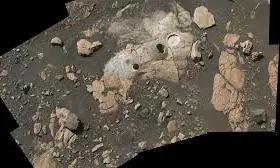
NASA's Perseverance rover detects potential organic molecules on Mars
text_fieldsNASA's Perseverance rover has uncovered intriguing evidence of carbon-based molecules within Mars' Jezero Crater, sparking discussions about the potential for ancient life on the planet.
Using the sophisticated SHERLOC instrument (Scanning Habitable Environments with Raman and Luminescence for Organics and Chemicals), the rover identified signals that could indicate the presence of organic compounds. However, researchers remain cautious as they explore alternative explanations for these findings.
SHERLOC employs two advanced techniques—ultraviolet luminescence and Raman spectroscopy—to detect possible organic materials.
While luminescence is highly sensitive to certain signals, it is not entirely specific, as non-organic materials can produce similar patterns. Raman spectroscopy, on the other hand, provides more accurate chemical fingerprints but is less sensitive overall. Together, these methods help scientists hypothesize about the existence of organic compounds on Mars, though the data remains inconclusive.
Some scientists believe the signals could stem from inorganic sources.
A study in Science Advances proposed that defects in minerals like phosphates and silicates, or the presence of cesium ions, might account for the detected patterns.
Dr. Eva Scheller, a planetary scientist from MIT and a co-author of the study, emphasized the challenges posed by overlapping spectral patterns, a phenomenon known as degeneracy in spectroscopy. The original research team has acknowledged these alternative possibilities, highlighting the complexities of remote analyses conducted on Mars.
The Jezero Crater, thought to have once been an ancient lakebed, is a prime location for studying potential signs of past life. While the detection of organic molecules does not confirm the existence of life, the crater’s geological history makes the discovery particularly compelling.
To confirm the origin of these carbon-based molecules, scientists stress the need for a Mars Sample Return mission. Such a mission would enable more detailed analysis in Earth-based laboratories, offering clearer insights into whether the compounds are biological or abiotic in origin.
























